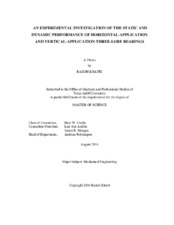| dc.description.abstract | Static and dynamic performance test results are provided for a horizontal-application three-lobe bearing evaluated over the following range of static-load orientations (all taken from the leading edge of the loaded pad): 0°, 20°, 30°, 40°, 60°, 80°, 90°, and 100°. This bearing has the following specifications: 100° pad arc angle, 0.52 preload, 70% offset, 101.74 mm (4.0057 in) minimum bore diameter, 0.116 mm (7.55 mils) radial pad clearance, and 76.3 mm (3 in) axial length. The static and dynamic test results are evaluated to determine the sensitivity of the bearing to changes in the static load direction. The two questions the study aims to answer are: (1) “Is an offset three-lobe bearing a good choice when the radial static load vector represents an unknown variable?” and (2) “Can an offset three-lobe bearing be oriented advantageously with a known load direction?” Both the static and dynamic test results are compared to predictions obtained from a fixed-arc bearing Reynolds equation solver. Predictions using both the measured hot clearance and measured cold clearance as inputs are compared to the measured data.
Dynamic tests show that the horizontal-application three-lobe bearing is sensitive to load orientation at low speeds and high loads. Whirl-frequency ratios (WFR) at 6750 rpm with loads of 1149 kPa, 1723 kPa, and 2298 kPa are equal to zero for loads oriented towards the leading edge of the pad, and between 0.35 and 0.5 for loads oriented towards the trailing edge of the pad. This same general trend can be seen for WFR values at 9000 rpm and 10800 rpm. The horizontal-application three-lobe bearing is not sensitive to load orientation at high speeds and light loads. At 13200 rpm, measured WFRs are between 0.3 and 0.7 at all loads and for all load orientations. Measured WFR at the no-load condition are between 0.45 and 0.7 for all cases.
Stiffness orthotropy was found to vary significantly with load orientation. At 6750 rpm and 2298 kPa, the bearing is most orthotropic when the static load orientation is 30° and 40°, with K_(yy) being larger than K_(xx) by approximately 800 MN/m. At 13200 rpm and 2298 kPa, the bearing is most orthotropic for the 40° and 100° load orientations, with K_(yy) being larger than K_(xx) by approximately 800 MN/m.
Overall, it is concluded that the three-lobe bearing is not a good choice when the load direction is unknown, as the bearing can have different rotordynamic coefficients with different load orientations. Also, at high speeds, the three-lobe bearing cannot be oriented advantageously with a known load direction to enhance stability, as the WFR of the three-lobe bearing tested is largely independent of load direction. However, the three-lobe bearing can be oriented advantageously to split/change a critical speed, since the direct stiffness and stiffness orthotropy change with load direction.
Additionally, dynamic performance test results are provided for a vertical-application (nominally unloaded) three-lobe bearing. The vertical-application bearing has the following specifications: 100° pad arc angle, 0.64 preload, 100% offset, 101.74 mm (4.0057 in) nominal diameter, 0.116 mm (5.27 mils) radial pad clearance, 76.3 mm (3in) axial length, and 100° static load orientation from the leading edge of the loaded pad. The performance of this bearing is evaluated to determine: (1) whether a fully (100%) offset three-lobe bearing configuration is more stable in terms of the WFR than a standard plain journal bearing and (2) whether a fully offset three-lobe bearing provides a larger direct stiffness (centering force) than a standard fixed-arc bearing.
Dynamic tests show that the vertical-application three-lobe bearing does not improve stability over conventional plain journal bearings. The measured WFRs for the vertical-application bearing are approximately 0.4-0.5 for nearly all test cases. Predicted WFRs are 0.46 at all test points. The vertical-application bearing dimensionless direct stiffness coefficients are compared to those for the horizontal-application bearing. The equivalent stiffness for the vertical-application bearing is larger than that of the horizontal-application bearing by a factor of 1.33 at 6750 rpm and a factor of 1.25 at 9000 rpm. Thus, the vertical-application bearing does impart a larger centering force to the journal relative to the horizontal-application bearing when the journal is not carrying a radial static load. | en |


